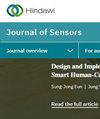利用激光诱导石墨烯呼吸传感器估算血氧饱和度
IF 1.4
4区 工程技术
Q3 ENGINEERING, ELECTRICAL & ELECTRONIC
引用次数: 0
摘要
测量血氧饱和度(SpO2)在分诊过程中对于识别呼吸窘迫或休克患者至关重要,因为低 SpO2 水平表明止血能力受损,需要优先治疗。本文探讨了如何使用基于激光诱导石墨烯(LIG)的可穿戴机械偏转传感器来估算 SpO2。LIG 传感器附着在受试者的胸部,用于实时监测呼吸信号。我们开发了一个新颖的呼吸信号数据库,其中包含从 86% 到 100% 的相应 SpO2 值。我们利用该数据库开发了一个人工神经网络模型,用于估算 SpO2。神经网络性能良好,回归指标均方误差 = 0.184,平均绝对误差 = 0.301,均方根误差 = 0.429,R 方 = 0.804。在生物传感中将机械呼吸传感器与神经网络结合使用,为无创 SpO2 监测和其他创新应用开辟了新的可能性。本文章由计算机程序翻译,如有差异,请以英文原文为准。
Blood Oxygen Saturation Estimation with Laser-Induced Graphene Respiration Sensor
Measuring blood oxygen saturation (SpO2) is crucial in a triage process for identifying patients with respiratory distress or shock, since low SpO2 levels indicate compromised hemostability and the need for priority treatment. This paper explores the use of wearable mechanical deflection sensors based on laser-induced graphene (LIG) for SpO2 estimation. The LIG sensors are attached to a subject’s chest for real-time monitoring of respiratory signals. We have developed a novel database of the respiratory signals, with corresponding SpO2 values ranging from 86% to 100%. The database is used to develop an artificial neural network model for SpO2 estimation. The neural network performance is promising, with regression metrics mean squared error = 0.184, mean absolute error = 0.301, root mean squared error = 0.429, and R-squared = 0.804. The use of mechanical respiration sensors in combination with neural networks in biosensing opens new possibilities for noninvasive SpO2 monitoring and other innovative applications.
求助全文
通过发布文献求助,成功后即可免费获取论文全文。
去求助
来源期刊

Journal of Sensors
ENGINEERING, ELECTRICAL & ELECTRONIC-INSTRUMENTS & INSTRUMENTATION
CiteScore
4.10
自引率
5.30%
发文量
833
审稿时长
18 weeks
期刊介绍:
Journal of Sensors publishes papers related to all aspects of sensors, from their theory and design, to the applications of complete sensing devices. All classes of sensor are covered, including acoustic, biological, chemical, electronic, electromagnetic (including optical), mechanical, proximity, and thermal. Submissions relating to wearable, implantable, and remote sensing devices are encouraged.
Envisaged applications include, but are not limited to:
-Medical, healthcare, and lifestyle monitoring
-Environmental and atmospheric monitoring
-Sensing for engineering, manufacturing and processing industries
-Transportation, navigation, and geolocation
-Vision, perception, and sensing for robots and UAVs
The journal welcomes articles that, as well as the sensor technology itself, consider the practical aspects of modern sensor implementation, such as networking, communications, signal processing, and data management.
As well as original research, the Journal of Sensors also publishes focused review articles that examine the state of the art, identify emerging trends, and suggest future directions for developing fields.
 求助内容:
求助内容: 应助结果提醒方式:
应助结果提醒方式:


